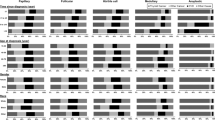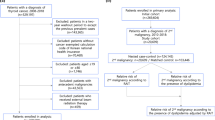Abstract
Purpose
The risk of cardiovascular diseases’ death (CVD) in patients with differentiated thyroid cancer (DTC) treated with radioactive iodine (RAI) after surgery has not been adequately studied.
Methods
Data of DTC patients who received RAI after surgery were retrieved from the Surveillance, Epidemiology, and End Result (SEER) database (2004–2015). Standardized mortality rate (SMR) analysis was used to evaluate the CVD risk in patients with RAI vs general population. A 1:1 propensity score matching (PSM) was applied to balance inter-group bias, and Pearson’s correlation coefficient was used to detect collinearity between variables. The Cox proportional hazard model and multivariate competing risk model were utilized to evaluate the impact of RAI on CVD. At last, we curved forest plots to compare differences in factors significantly associated with CVD or cancer-related deaths.
Results
DTC patients with RAI treatment showed lower SMR for CVD than general population (RAI: SMR = 0.66, 95% CI 0.62–0.71, P < 0.05). After PSM, Cox proportional hazard regression demonstrated a decreased risk of CVD among patients with RAI compared to patients without (HR = 0.76, 95% CI 0.6–0.97, P = 0.029). However, in competing risk regression analysis, there was no significant difference (adjusted HR = 0.82, 95% CI 0.66–1.01, P = 0.11). The independent risk factors associated with CVD were different from those associated with cancer-related deaths.
Conclusion
The CVD risk between DTC patients treated with RAI and those who did not was no statistical difference. Noteworthy, they had decreased CVD risk compared with the general population.






Similar content being viewed by others
Data availability
The datasets generated during and analyzed during the current study are available from the corresponding author on reasonable request.
Abbreviations
- CVD:
-
Cardiovascular diseases’ death
- RAI:
-
Radioactive iodine
- TCD:
-
Thyroid cancer death
- OCD:
-
Other cancer death
- ONCD:
-
Other non-cancer death
- TC:
-
Thyroid cancer
- DTC:
-
Differentiated thyroid cancer
- PSM:
-
Propensity score matching
- SMR:
-
Standardized mortality rate
- SEER:
-
Surveillance, Epidemiology, and End Results
References
Sung H et al (2021) Global Cancer Statistics 2020: GLOBOCAN estimates of incidence and mortality worldwide for 36 cancers in 185 countries. CA Cancer J Clin 71(3):209–249
Kitahara CM, Sosa JA (2016) The changing incidence of thyroid cancer. Nat Rev Endocrinol 12(11):646–653
Miller KD et al (2019) Cancer treatment and survivorship statistics, 2019. CA Cancer J Clin 69(5):363–385
Siegel RL et al (2021) Cancer Statistics, 2021. CA Cancer J Clin 71(1):7–33
Rahib L et al (2014) Projecting cancer incidence and deaths to 2030: the unexpected burden of thyroid, liver, and pancreas cancers in the United States. Cancer Res 74(11):2913–2921
Pajamäki N et al (2018) Long-term cardiovascular morbidity and mortality in patients treated for differentiated thyroid cancer. Clin Endocrinol (Oxf) 88(2):303–310
Suh B et al (2019) Increased cardiovascular risk in thyroid cancer patients taking levothyroxine: a nationwide cohort study in Korea. Eur J Endocrinol 180(1):11–20
Mazzaferri EL, Kloos RT (2001) Clinical review 128: Current approaches to primary therapy for papillary and follicular thyroid cancer. J Clin Endocrinol Metab 86(4):1447–1463
Giovanella L, Scappaticcio L (2019) Radioiodine therapy of advanced differentiated thyroid cancer: clinical considerations and multidisciplinary approach. Q J Nucl Med Mol Imaging 63(3):229–234
Wyszomirska A (2012) Iodine-131 for therapy of thyroid diseases. Physical and biological basis. Nucl Med Rev Cent East Eur 15(2):120–123
Kim KJ et al (2020) Effects of radioactive iodine treatment on cardiovascular disease in thyroid cancer patients: a nationwide cohort study. Ann Transl Med 8(19):1235
Kao CH et al (2021) Radioactive iodine treatment and the risk of long-term cardiovascular morbidity and mortality in thyroid cancer patients: a nationwide cohort study. J Clin Med 10(17):4032
Klein Hesselink EN et al (2015) Increased risk of atrial fibrillation after treatment for differentiated thyroid carcinoma. J Clin Endocrinol Metab 100(12):4563–4569
la Cour JL et al (2015) Radioiodine therapy increases the risk of cerebrovascular events in hyperthyroid and euthyroid patients. Eur J Endocrinol 172(6):771–778
Little MP et al (2008) A systematic review of epidemiological associations between low and moderate doses of ionizing radiation and late cardiovascular effects, and their possible mechanisms. Radiat Res 169(1):99–109
Stewart FA (2012) Mechanisms and dose-response relationships for radiation-induced cardiovascular disease. Ann ICRP 41(3–4):72–79
Ravera S et al (2017) The sodium/iodide symporter (NIS): Molecular physiology and preclinical and clinical applications. Annu Rev Physiol 79:261–289
Carmona R et al (2016) Improved method to stratify elderly patients with cancer at risk for competing events. J Clin Oncol 34(11):1270–1277
Sturgeon KM et al (2019) A population-based study of cardiovascular disease mortality risk in US cancer patients. Eur Heart J 40(48):3889–3897
Fung C et al (2015) Cardiovascular disease mortality after chemotherapy or surgery for testicular nonseminoma: a population-based study. J Clin Oncol 33(28):3105–3115
Sun S, Wang W, He C (2021) Cardiovascular mortality risk among patients with gastroenteropancreatic neuroendocrine neoplasms: a registry-based analysis. Oxid Med Cell Longev 2021:9985814
Liao Y, Yin G, Fan X (2020) The Positive lymph node ratio predicts survival in T(1–4)N(1–3)M(0) non-small cell lung cancer: a nomogram using the seer database. Front Oncol 10:1356
Scrucca L, Santucci A, Aversa F (2007) Competing risk analysis using R: an easy guide for clinicians. Bone Marrow Transplant 40(4):381–387
Filleron T et al (2010) An R function to non-parametric and piecewise analysis of competing risks survival data. Comput Methods Programs Biomed 100(1):24–38
Ryödi E et al (2018) Cardiovascular morbidity and mortality after treatment of hyperthyroidism with either radioactive iodine or thyroidectomy. Thyroid 28(9):1111–1120
Sylvester CB et al (2018) Radiation-induced cardiovascular disease: mechanisms and importance of linear energy transfer. Front Cardiovasc Med 5:5
Şanal B et al (2016) Effect of radioactive iodine therapy on carotid intima media thickness in patients with hyperthyroidism. Ann Nucl Med 30(1):75–80
Haugen BR et al (2016) 2015 American thyroid association management guidelines for adult patients with thyroid nodules and differentiated thyroid cancer: the american thyroid association guidelines task force on thyroid nodules and differentiated thyroid cancer. Thyroid 26(1):1–133
Filetti S et al (2019) Thyroid cancer: ESMO Clinical Practice Guidelines for diagnosis, treatment and follow-up†. Ann Oncol 30(12):1856–1883
Jabbar A et al (2017) Thyroid hormones and cardiovascular disease. Nat Rev Cardiol 14(1):39–55
Klein I, Ojamaa K (2001) Thyroid hormone and the cardiovascular system. N Engl J Med 344(7):501–509
Klein I, Danzi S (2016) Thyroid Disease and the Heart. Curr Probl Cardiol 41(2):65–92
Gammage MD et al (2007) Association between serum free thyroxine concentration and atrial fibrillation. Arch Intern Med 167(9):928–934
Collet TH et al (2012) Subclinical hyperthyroidism and the risk of coronary heart disease and mortality. Arch Intern Med 172(10):799–809
Baumgartner C et al (2017) Thyroid function within the normal range, subclinical hypothyroidism, and the risk of atrial fibrillation. Circulation 136(22):2100–2116
Mo X et al (2021) Competing risk analysis of cardiovascular/cerebrovascular death in T1/2 kidney cancer: a SEER database analysis. BMC Cancer 21(1):13
Demers M et al (2012) Cancers predispose neutrophils to release extracellular DNA traps that contribute to cancer-associated thrombosis. Proc Natl Acad Sci USA 109(32):13076–13081
Cedervall J, Dimberg A, Olsson AK (2016) Tumor-induced neutrophil extracellular traps-drivers of systemic inflammation and vascular dysfunction. Oncoimmunology 5(3):e1098803
Papadopoulos FC (2012) Suicide and cardiovascular death after a cancer diagnosis. N Engl J Med 367(3):276–277
Acknowledgements
We acknowledge the contributions of the SEER program registries for creating and updating the SEER database.
Funding
The authors did not receive support from any organization for the submitted work.
Author information
Authors and Affiliations
Contributions
All authors contributed to the study conception and design. Material preparation, data collection, and analysis were performed by HFZ and HYX. The first draft of the manuscript was written by HFZ and all authors commented on previous versions of the manuscript. All authors read and approved the final manuscript.
Corresponding author
Ethics declarations
Conflict of interest
The authors have no relevant financial or non-financial interests to disclose.
Ethical approval
This study was granted exemption by the Institutional Review Board of Sichuan University because of the publicity and anonymity of SEER data.
Research involving human participants and/or animals
This article does not contain any studies with human participants or animals performed by any of the authors.
Informed consent
For this type of study, formal consent is not required.
Additional information
Publisher's Note
Springer Nature remains neutral with regard to jurisdictional claims in published maps and institutional affiliations.
Supplementary Information
Below is the link to the electronic supplementary material.
Rights and permissions
Springer Nature or its licensor (e.g. a society or other partner) holds exclusive rights to this article under a publishing agreement with the author(s) or other rightsholder(s); author self-archiving of the accepted manuscript version of this article is solely governed by the terms of such publishing agreement and applicable law.
About this article
Cite this article
Zhang, H., Xie, H. & Li, L. Association of radioactive iodine treatment in differentiated thyroid cancer and cardiovascular death: a large population-based study. J Endocrinol Invest 47, 443–453 (2024). https://doi.org/10.1007/s40618-023-02159-4
Received:
Accepted:
Published:
Issue Date:
DOI: https://doi.org/10.1007/s40618-023-02159-4




